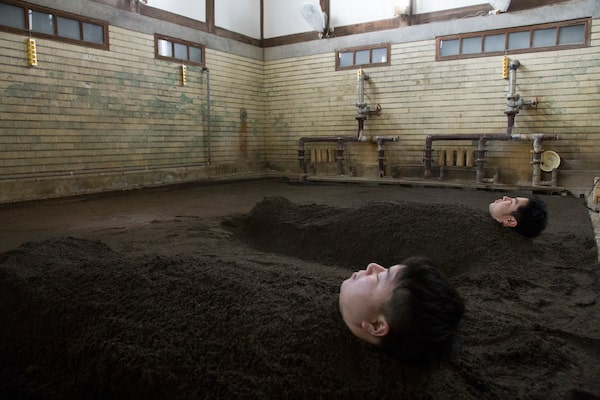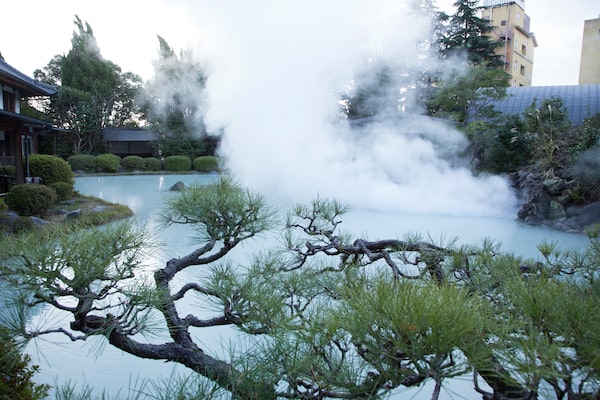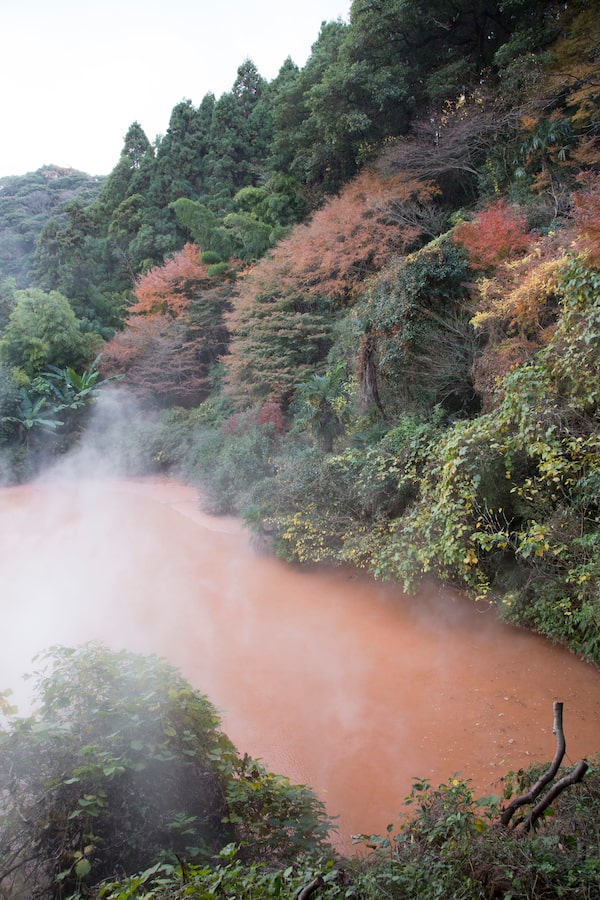
The Takegawara Onsen is in a 19th-century wooden structure in the centre of Beppu.JNTO
Not a natural exhibitionist, it is with great trepidation that I remove my towel – that last bastion of modesty – in public, outside, under sunny skies. Hanging it on a wooden railing, I step into the impenetrable murk of the muddy, steaming hot springs bath.
I quickly submerge myself, then linger at the back near a pile of rocks, leaning back and taking inventory. Close by, several young dudes laugh and steal glances at the other side of the space, while across the divide – marked by a single bamboo pole, laid crosswise over the muddy, mineral-rich water – a handful of young women, all of them wearing shower caps and nothing else, have their own round of conversation, just their necks and heads visible. Everyone but me is Japanese.
Japan is a country shot through with hot springs, some 27,000, by one count, and I’m here in Beppu – the most famous onsen town of them all. An essential part of the Japanese culture, an onsen visit is steeped in tradition; according to legends dating back to ancient times, deities here were healed by the hot springs’ powers. The experience also involves strict protocols, and those who visit these baths are expected to respect the mores set out for this important cultural practice. Shower and scrub beforehand. Tattoos? Sometimes they’re allowed – but check first. Don’t BYOB (it’s not that kind of hot tub). And rule No. 1? You must be – at all times – completely naked.
Set on the sea, Beppu is a small city of about 120,000 perched on a mountainside on Japan’s southern Kyushu Island. Famous in Japan but almost unknown to westerners, Beppu descends from Kyushu’s mountains to the sea, with steam rising from vents in the earth seemingly every few steps. The slopes steam year-round and the area’s 2,000 hot springs have long attracted people from across the country.
Next year, the city will welcome visitors from around the globe as a host site for the Rugby World Cup. And some of the attractions here, it should be noted, can be enjoyed fully-clothed. For example, the “eight hells of Beppu,” a series of bubbling pools – each one with a different theme – that descend down the mountain. One has little foot baths; at another, you can cook your lunch using magmatic power, and I enjoy a steam bun meal thoroughly heated from forces far beneath the earth.

The approximately 2,000 hot springs in the Beppu area have long drawn visitors from across Japan.JNTO
But it’s not long before I’m back in the buff, and the next time I get naked, I’m soon covered in volcanic sand. Visiting the historic Takegawara Onsen, a 19th-century building in the heart of town, I enter the hulking, haunting wooden structure after dark, paying a minimal fee to the woman behind the window. She hands me a locker key, a slender towel and a robe, and the shedding of clothing begins. First, I trade my shoes for a pair of rubber slippers. Entering the locker room, I strip down to nothing, robing up only after first following intricate onsen bathing rituals, including sitting on a little stool and showering off near a steaming pool of geothermal water.
Then, it’s time to climb into a grave – or, at least that’s what it looks like. Digging a series of identical plots, two women work like clockwork, tossing aside the heavy sand with their spades. One directs me to my designated excavation and I lie flat, a block of wood supporting my head. Working together in choreographed routine, they pack the soil all over me, up to my neck and around my head, even my limbs sealed in. It’s hot, and I sweat freely while I fight a mild bout of claustrophobia. After 15 minutes, I am relieved – but my skin no doubt enriched – as I climb out and head back to the locker room.
There, I disrobe, brush off all the sand that has migrated into my every nook and cranny and head to a hot pool. I share the space with a father and son from Osaka and we make stilted conversation as the three of us scoop water over our heads, shampooing thoroughly. As we get dressed, the father congratulates me on my naked, brazen bravery and we share an awkward combination high-five and handshake that seems to stretch on forever. It’s uncomfortable, but I feel good about myself. Striding out into the sultry Kyushu night, I’m confident, well-moisturized and ready for the next opportunity to toss aside my pants.

Chi-no Ike Jigoku – one of the 'eight hells of Beppu.'JNTO
When you go
Soak: Hoyo Land offers clean, functional facilities for mineral-reach, co-ed bathing – a day pass costs 1,000 yen ($11.75). And for about the same price at Takegawara Spa, you can get buried up to your neck in sand at Beppu’s most famous onsen, which dates back to 1879.
Stay: Further south on Kyushu, Myoken Ishiharaso is one of Japan’s finest onsen resorts, with a series of picturesque public baths lining the banks of the rushing Amorigawa River. It’s a place where immersion of all sorts is the norm, offering Japanese-style guestrooms and a 10-course traditional tasting menu. Then wander back to your suite and take a soak in your own private hot springs bath, on the balcony. Rooms from 23,760 yen ($279); m-ishiharaso.com/en
Almost all itineraries to Kyushu and Beppu will run through Tokyo. There, tucked away from the mayhem in the Toranomon Hills, the Andaz Tokyo occupies the top floors of the city’s second-tallest building, mixing Japanese design elements (round tubs, lanterns, washi paper partitions with traditional western comforts. Great place for a two-to-three-day layover, en route south to Kyushu. Rooms from 55,000 yen ($646); tokyo.andaz.hyatt.com
Get there: Air Canada provides direct flights from Toronto to Tokyo’s Haneda International Airport. From there, you can either take a day to ride the high-speed Shinkansen (bullet train), or hop onto a short connector flight to Oita or Kagoshima on Kyushu Island.
The writer received a complimentary stay at Myoken Ishiharaso. It did not review or approve this article.
.